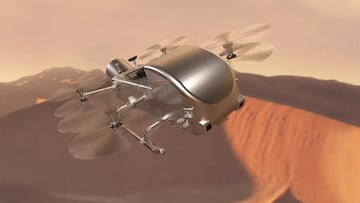NASA Dragonfly Mission: What is it and why was Elon Musk’s SpaceX chosen?
Expanding on the success of Ingenuity, NASA will send another first of its kind helicopter mission to explore outside Earth, Saturn’s biggest moon Titan.

Earlier this year, NASA gave the final green light to its Dragonfly Mission after being replanned several times and delayed by two years since it was originally selected in 2019. This was the result of funding constraints caused from the price tag of the mission roughly doubling to $3.35 billion for the total lifecycle of the mission.
“The project incurred additional costs due to the COVID-19 pandemic, supply chain increases, and the results of an in-depth design iteration,” explained the US space agency.
NASA Dragonfly Mission: why was Elon Musk’s SpaceX chosen?
Additional funding was also required to make sure that the space probe could get to its destination, Saturn’s biggest moon Titan, by 2034. In order to reduce the cruise phase of Dragonfly mission’s journey, NASA needed it to be carried into space by a heavy-lift launch vehicle.
On Monday, the US space agency announced that it had selected Elon Musk’s SpaceX to provide launch services for the mission. A SpaceX Falcon Heavy rocket will carry NASA’s Dragonfly into space for around $256.6 million under a firm-fixed-price contract that includes launch and other mission related costs.
NASA Dragonfly Mission: What is it?
The Dragonfly mission is the fourth of NASA’s New Frontiers Program, which includes New Horizons, Juno and OSIRIS-Rex, now renamed OSIRIS-APEX. This mission, designed and built under the direction of the Johns Hopkins Applied Physics Laboratory (APL), is NASA’s latest helicopter that will explore a world beyond Earth.
“Exploring Titan will push the boundaries of what we can do with rotorcraft outside of Earth,” said Nicky Fox, associate administrator, Science Mission Directorate at NASA Headquarters in Washington.
Ingenuity was the first of this type of vehicle to explore an alien terrain arriving on Mars in February 2021 on the underside of the Perseverance rover. That mission far exceeded expectations but, sadly, after more than 3 years on the Red Planet it sustained debilitating damage during a hard landing.
You may also be interested in: NASA’s mini helicopters mission to Mars
Titan could habor the building blocks of life
The target, Titan, is intriguing for scientists searching for the building blocks of life. Carbon-rich material and liquid water on Saturn’s biggest moon may have mixed for an extended period of time.
Dragonfly, if everything works properly, will be able travel between diverse sites and take samples to determine surface composition in different geologic settings in order to characterize the habitability of Titan’s environment. The hope is to find chemical indications of whether water-based or hydrocarbon-based life once existed on Saturn’s moon.
Related stories
NASA’s is currently targeting a launch for the Dragonfly mission from July 5, 2028, to July 25, 2028, from Launch Complex 39A at NASA’s Kennedy Space Center in Florida.
Get your game on! Whether you’re into NFL touchdowns, NBA buzzer-beaters, world-class soccer goals, or MLB home runs, our app has it all. Dive into live coverage, expert insights, breaking news, exclusive videos, and more – plus, stay updated on the latest in current affairs and entertainment. Download now for all-access coverage, right at your fingertips – anytime, anywhere.


